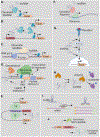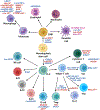LNCing RNA to immunity
- PMID: 35501219
- PMCID: PMC9647660
- DOI: 10.1016/j.it.2022.04.002
LNCing RNA to immunity
Abstract
Despite an ever-increasing appreciation of how protein-coding genes shape immune responses, the molecular underpinnings of immune regulation remain incompletely understood. This incomplete picture impedes the development of more precise therapeutics and diagnostics for immune-mediated diseases. Long noncoding RNAs (lncRNAs) are versatile cell- and context-specific regulators of gene expression and cellular function. The number of lncRNA genes rivals that of protein-coding genes; however, comparatively little is known about their function. Even though the functions of most lncRNA genes are unknown, multiple lncRNAs have recently emerged as important immune regulators. Therefore, further unlocking the role of lncRNAs in the mammalian immune system coupled with their tissue-specific expression might lead to more precise therapeutics and diagnostics for immune disorders in general.
Keywords: alloimmunity; antitumor immunity; autoimmunity; immunity; inflammatory immune disorders; long noncoding RNA.
Copyright © 2022. Published by Elsevier Ltd.
Conflict of interest statement
Declaration of interests The authors declare no conflicts of interest.
Figures


Similar articles
-
Immunobiology of Long Noncoding RNAs.Annu Rev Immunol. 2017 Apr 26;35:177-198. doi: 10.1146/annurev-immunol-041015-055459. Epub 2017 Jan 11. Annu Rev Immunol. 2017. PMID: 28125358 Free PMC article. Review.
-
Long non-coding RNAs and control of gene expression in the immune system.Trends Mol Med. 2014 Nov;20(11):623-31. doi: 10.1016/j.molmed.2014.09.002. Epub 2014 Sep 25. Trends Mol Med. 2014. PMID: 25262537 Free PMC article. Review.
-
Emerging role of lncRNAs in systemic lupus erythematosus.Biomed Pharmacother. 2018 Oct;106:584-592. doi: 10.1016/j.biopha.2018.06.175. Epub 2018 Jul 11. Biomed Pharmacother. 2018. PMID: 29990846 Review.
-
Control of Immune Cell Homeostasis and Function by lncRNAs.Trends Immunol. 2018 Jan;39(1):55-69. doi: 10.1016/j.it.2017.08.009. Epub 2017 Sep 14. Trends Immunol. 2018. PMID: 28919048 Free PMC article. Review.
-
Integrated analysis of mRNA and long non-coding RNA expression profiles reveals the potential roles of lncRNA-mRNA network in carp macrophage immune regulation.In Vitro Cell Dev Biol Anim. 2021 Sep;57(8):835-847. doi: 10.1007/s11626-021-00610-5. Epub 2021 Sep 23. In Vitro Cell Dev Biol Anim. 2021. PMID: 34554377
Cited by
-
From periphery to center stage: 50 years of advancements in innate immunity.Cell. 2024 Apr 25;187(9):2030-2051. doi: 10.1016/j.cell.2024.03.036. Cell. 2024. PMID: 38670064 Free PMC article. Review.
-
Research Progress of Long Non-Coding RNA in Tumor Drug Resistance: A New Paradigm.Drug Des Devel Ther. 2024 Apr 26;18:1385-1398. doi: 10.2147/DDDT.S448707. eCollection 2024. Drug Des Devel Ther. 2024. PMID: 38689609 Free PMC article. Review.
-
Expression pattern of long non-coding RNAs in treatment-naïve and medicated schizophrenia patients.Sci Rep. 2024 Nov 12;14(1):27654. doi: 10.1038/s41598-024-78220-w. Sci Rep. 2024. PMID: 39532914 Free PMC article.
-
The role of long noncoding RNA SNHG29 in malignant tumors.Discov Oncol. 2025 Jul 15;16(1):1334. doi: 10.1007/s12672-025-03189-5. Discov Oncol. 2025. PMID: 40663245 Free PMC article. Review.
-
Research progress and perspectives of non-coding RNAs in primary biliary cholangitis: from mechanisms to therapeutics.Front Med (Lausanne). 2025 Aug 4;12:1611640. doi: 10.3389/fmed.2025.1611640. eCollection 2025. Front Med (Lausanne). 2025. PMID: 40832105 Free PMC article. Review.
References
Publication types
MeSH terms
Substances
Grants and funding
LinkOut - more resources
Full Text Sources
Medical

